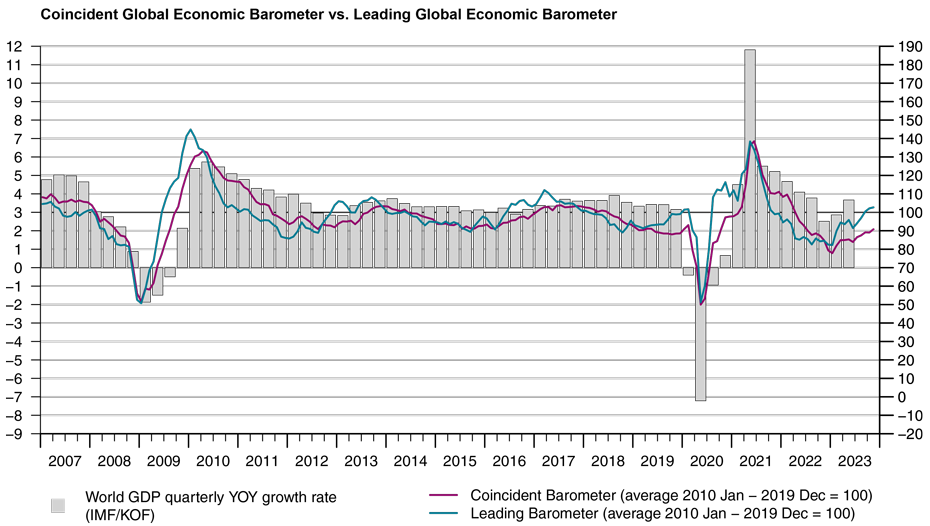Leading Global Barometer signals a more favourable outlook for the coming months
Both Global Barometers improve in November. The Leading Global Barometer points to an acceleration in world economic growth in the three to six months ahead. The Coincident Barometer is rising despite the monetary tightening in several countries, but it remains below its historical average.

The Coincident Global Economic Barometer increases by 1.7 points to 90.8 points in November, while the Leading Barometer rises by 0.6 points to 102.7 points, its highest level since September 2021 (108.4 points). All the regions have a positive impact on both indicators, except for Europe in the case of the Leading Barometer. The gap between the two Global Barometers remains more than 10 points for the third month in a row.
“Despite ongoing and recent military conflicts, consumers are gradually becoming less pessimistic about the near future, as evidenced by a further improvement in the outlook for retail and wholesale trade and, in particular, services. While the global industrial sector is facing recessionary tendencies, partly reflecting an inventory cycle - more and more firms have reversed their assessment of their input inventories from too low to too high - the construction sector is being hit by historically high interest rates. However, both are adjusting to the situation, as evidenced by improved expectations in these sectors as well”, evaluates Jan-Egbert Sturm, Director of KOF Swiss Economic Institute.

“Despite ongoing and recent military conflicts, consumers are gradually becoming less pessimistic about the near future.”Jan-Egbert Sturm, Director of KOF Swiss Economic Institute
Coincident Barometer – regions and sectors
The increase in the Coincident indicator was mainly driven by the contribution of the Asia, Pacific & Africa region with 1.2-point, followed by Europe and the Western Hemisphere with 0.4 and 0.2 points, respectively. All three regional indicators are in the 91-92 point range, suggesting a below-normal level of global activity due to the various economic challenges faced by several countries. The graph below illustrates the contribution of each region to the deviation of the Coincident Barometer from its historical average of 100 points.
All Coincident sector indicators developed positively in November, with the exception of the Economy (aggregated business and consumer evaluations) indicator, which declined slightly. The (retail and wholesale) Trade indicator has been developing favourably since July of this year, pulling away from the other sectors.
Leading Barometer – regions and sectors
The Leading Global Barometer leads world economic growth by an average of three to six months. In November, the positive regional contributions are coming from the Western Hemisphere and the Asia, Pacific & Africa region with 0.5 and 0.3 points, respectively, while Europe is contributing negatively with 0.2 points. The level of the indicators suggests that the prospects for an acceleration in economic growth will become more widespread in the coming months, with the indicators for Europe and the Western Hemisphere hovering around the neutral level of 100 points and the indicator for the Asia, Pacific & Africa region taking a more optimistic stance.
In November, the Leading sector indicators for Construction, Services, and Trade are increasing, while those for the Economy and Industry are decreasing. The indicators for Services and Trade reach their highest levels since the end of 2021, reflecting a positive outlook for the coming months.

The Global Economic Barometers
The Global Economic Barometers are a system of indicators enabling timely analysis of global economic development. They represent a collaboration between the KOF Swiss Economic Institute of the ETH Zurich in Switzerland and Fundação Getulio Vargas (FGV), based in Rio de Janeiro, Brazil. The system consists of two composite indicators, the Coincident Barometer and the Leading Barometer. The Coincident Barometer reflects the current state of economic activity, while the Leading Barometer provides a cyclical signal roughly six months ahead of current economic developments.
The two Barometers comprise the results of economic tendency surveys conducted in more than 50 countries with the aim of achieving the broadest possible global coverage. The advantages of economic tendency surveys are that their results are usually readily available and are not substantially revised after first publication.
The Coincident Barometer includes more than 1,000 different time series, while the Leading Barometer consists of over 600 time series. Cross-correlation analysis is used to decide which individual time series are included in the barometers. This involves correlating the individual time series with a reference series. The reference series used is the year-on-year growth rate of global gross domestic product (GDP), where the individual national GDPs are aggregated at purchasing power parity to form global GDP. A time series is only included in a Barometer if it shows a sufficiently high correlation and a suitable synchronization or lead with the reference series. The time period used for this correlation analysis currently runs from January 2010 to December 2019.
The series of the two Barometers are revised each month at publication and are standardized to have a mean of 100 and a standard deviation of 10 for the 10-year period previous to the most recent observations.
The methodology is described in:
Klaus Abberger, Michael Graff, Aloisio Jr. Campelo, Anna Carolina Lemos Gouveia, Oliver Müller and Jan-Egbert Sturm (2020), The Global Economic Barometers: Composite indicators for the world economy. KOF Working Papers, vol. 471, Zurich: KOF Swiss Economic Institute, ETH Zurich, 2020.
Contact
KOF Konjunkturforschungsstelle
Leonhardstrasse 21
8092
Zürich
Switzerland

